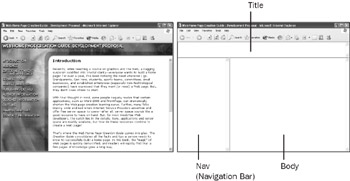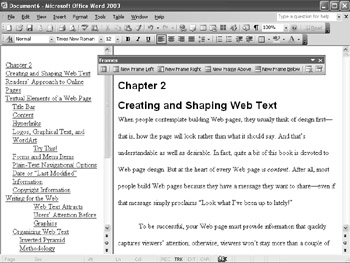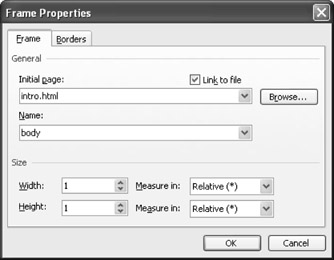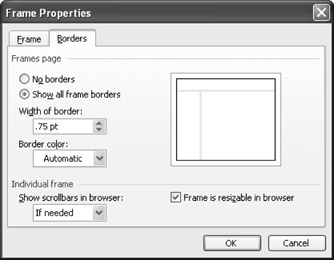Adding Frames when Designing Online Documents
|
| < Day Day Up > |
|
If you're creating documents that will be viewed online, you can take advantage of frames to organize your documents. Frames enable you to create areas for the text on your screen that allow you to divide a window into multiple areas so that you can show several documents at one time. Frames are frequently used in Web page design and for long documents on enterprise networks. For example, frames might be used to create an interface for a human resource manual.
Web designers commonly use frames to create several window regions, each of which shows specific types of information. For example, frames are sometimes used to create a menu bar that contains links to pages on a Web site. Users click links on the menu bar in one frame to display selected information in another target frame that serves as the main content area. Figure 17-3 shows a Web page that uses three frames-one title area frame, a navigation bar frame, and a body frame.

Figure 17-3: The Web page design on the left is based on a framework of three frame areas, as shown on the right.
The basic idea behind a frames page is that you create a page that defines how the window will be divided (which acts somewhat like your page's skeleton), and then you specify which document should appear in each frame. When you upload a page that uses frames to a server, you must copy the frames page as well as the files that contain the frames' contents. When you save a document that uses frames in Word-whether you save the document as a Word document or a Web page-Word creates a separate file for the content in each area as well as a frames page that defines the view. Thus, the Web page shown in Figure 17-3 would consist of at least four files-the title bar file, the navigation bar file, the main body text file, and the frames page file (which defines how the content files are shown in the window). To reopen a document that uses frames in Word, you simply open the frames page document.
Note that creating frames pages in Word differs from converting a text box into a frame or using a floating frame to contain information (such as field codes) on a page. When you use a frame container in a Word document and then save the document as a Web page, Word converts the floating frame into a table (using the <TABLE></TABLE> Hypertext Markup Language (HTML) tag set). In this case, browsers will show floating frames as standard content held in position by tables, and Word won't save the frame content in a separate file.
| Note | Using frames to create Web pages can take some finagling. If you're new to frames and you're creating a Web page, you should do some research about frames online or consult some of the many Web page design books. |
Adding Frames to Documents
You can add frames to a document using any of the following techniques:
-
Choose Format, Frames, New Frames Page to open a new document and display the Frames toolbar, which you can use to add frames to the new document.
-
Choose View, Toolbars, Frames to display the Frames toolbar, which you can use to create frames in the current document.
-
Choose Format, Frames, Table Of Contents In Frame to create a left frame that contains links to the headings in the current document. (The document must be formatted with built-in Word headings for this option to work properly.)
Cross-Reference For more information about creating Web pages, see Chapter 26, "Creating Professional Web Sites."
The tools you need to create and manage frames can be found on the Frames toolbar, shown in Figure 17-4. (You can also access frames options when you're working in a frames page by choosing Format, Frames.)
![]()
Figure 17-4: You can click buttons on the Frames toolbar to add and delete frames in a frames page.
Using the Frames toolbar, you can add a frame to the current document by clicking one of the position buttons: New Frame Left, New Frame Right, New Frame Above, or New Frame Below. After you add a frame, you can resize it by dragging the frame's border.
| Tip | Insert top and bottom frames If you're going to include top or bottom frames in your document along with a left or right frame, you should create the top or bottom frames first. That way, the top or bottom frame will span the entire width of the page. |
![]() In addition to creating standard frames, you can have Word automatically generate a frame that contains links to the headings in your document. If your document uses built-in Word heading styles, you can click the Table Of Contents In Frame button (or choose Format, Frames, Table Of Contents In Frame) to create a linked table of contents in a left frame, as shown in Figure 17-5. You can format an automatically generated table of contents frame in the same way you format other frames and documents.
In addition to creating standard frames, you can have Word automatically generate a frame that contains links to the headings in your document. If your document uses built-in Word heading styles, you can click the Table Of Contents In Frame button (or choose Format, Frames, Table Of Contents In Frame) to create a linked table of contents in a left frame, as shown in Figure 17-5. You can format an automatically generated table of contents frame in the same way you format other frames and documents.

Figure 17-5: The Tables Of Contents In Frame option enables you to quickly create a left frame that contains links to each heading in your document.
When you use this option and then save the document as a Web page (.htm or .html), Word automatically creates three documents-one document that defines the structure of the page (the frameset page), a document that contains the main content, and a document that contains the table of contents frame information. To reopen the frame page, open the frameset document, which is often the smallest document (such as 1 KB) and has the name you assigned to the document when you saved it as a Web page. Word names the table of contents page by using the first item in the list of contents.
| Tip | Specify how to follow hyperlinks while working in Word To use the links in a table of contents frame in Word, press Ctrl as you click the link. If you want to be able to click links without having to press Ctrl, choose Tools, Options, click the Edit tab, and then clear the Use Ctrl+Click To Follow Hyperlink check box. |
Controlling Frame Properties
![]() As with most constructs created in Word, a frame's properties can be controlled by configuring settings in a properties dialog box, in this case the Frame Properties dialog box. The two main areas of concern when you're working with frames are the content and frame's appearance. To open the Frame Properties dialog box, click the frame you want to format, and then click Frame Properties on the Frames toolbar or choose Format, Frames, Frame Properties. The Frame Properties dialog box is described in more detail in the next section of the chapter.
As with most constructs created in Word, a frame's properties can be controlled by configuring settings in a properties dialog box, in this case the Frame Properties dialog box. The two main areas of concern when you're working with frames are the content and frame's appearance. To open the Frame Properties dialog box, click the frame you want to format, and then click Frame Properties on the Frames toolbar or choose Format, Frames, Frame Properties. The Frame Properties dialog box is described in more detail in the next section of the chapter.
Assigning Documents and Names to Frames
When you create a frames page, Word displays a different document in each frame. You might have to tell Word which document to display in which frame. (If you create a frames page from scratch, Word will automatically generate file names and documents for you.) You can specify documents to associate with a frame by configuring settings in the Frame tab in the Frame Properties dialog box, shown in Figure 17-6.

Figure 17-6: Using the Frame tab, you can perform a number of frame configuration tasks, including naming a frame and assigning a document to appear in the frame when the frames page opens.
In the Frame tab, you can indicate which page to display in a frame by inserting the file's path and name in the Initial Page box. The file specified in the Initial Page box is the file that appears each time the frames page is opened. You can also select the Link To File check box to ensure that the document used in your frames page is updated each time the Initial Page file is changed.
In addition to specifying which file is initially displayed in a frame, you can assign a name to each frame. When you use frames, the frames must be named so that you can refer to specific frames when you create hyperlinks. For example, the Frame tab shown in Figure 17-6 specifies that the intro.html file appear in a frame named body. The Introduction hyperlink in the navigation frame shown previously in Figure 17-3 is configured to open the intro.html file in the frame named body when the hyperlink is clicked. The frames page shown in Figure 17-3 contains frames named title, body, and nav (short for navigation bar).
| Cross-Reference | To learn more about creating hyperlinks and specifying frame targets, see Chapter 26, "Creating Professional Web Sites." |
| Note | Frame names are case-sensitive and can include numbers and letters. Also, because each frame must have a name, Word automatically provides default names for frames that aren't named manually. |
The remaining frame parameters that you can configure in the Frame tab are the frame's height and width. You can assign height and width measurements in the Height and Width boxes and use the Measure In lists to specify whether the measurements are a percentage of the screen size, a fixed size in inches, or relative to the other frames, as follows:
-
Percent Specifies that a frame's height or width should be sized as a percentage of the window. For example, if a frame's width is set to 50 percent, the frame will consume half the width of a user's window, regardless of the size of the window.
-
Inches Specifies a fixed width or height in inches. The frame will always be displayed at the specified height, regardless of the size of the window.
-
Relative (*) Indicates that the frame's height or width should fill the remaining area of the window after the other frame settings are applied. For example, if a top frame is set to 1 inch and a bottom frame is set to 1 inch, the body frame could be set to Relative so that the frame fills the area between the top and bottom frames, regardless of the size of the window.
Frequently you'll find that your document uses a combination of Percent, Inches, and Relative settings. If you prefer, you can adjust the sizes of the frames in your document by dragging frame borders, and Word will automatically configure your frame size settings for you.
Troubleshooting: Some of my frame pages are missing
If you find that a frame doesn't display an initial page when you open your frames page, you need to check the Initial Page setting in the frame's Frame Properties dialog box.
To display the Frame Properties dialog box, click in the frame; choose Format, Frames, Frame Properties; and then click the Frame tab. After you display the Frame tab, make sure that the path and file name in the Initial Page box are accurate and point to a valid file. Keep in mind that whenever you rename a file that's referred to in a frames page, you must modify the frames page's Frame Properties settings as well.
Controlling Frame Borders, Resizing Capabilities, and Scroll Bars
In addition to controlling which documents are displayed in frames and assigning sizes and names to frames, you can control frame borders and scrollbars. To access frame border and scrollbar properties, follow these steps:
-
Click the frame you want to format.
-
Click Frame Properties on the Frames toolbar, or choose Format, Frames, Frame Properties.
-
Click the Borders tab, shown in Figure 17-7.

Figure 17-7: The Borders tab in the Frame Properties dialog box provides settings you can use to specify how frame borders and scrollbars appear in the current document.
The settings available on the Borders tab are as follows:
-
No Borders Choose this option if you want your frames to be displayed seamlessly, without borders.
-
Show All Frame Borders Choose this option if you want borders to be displayed.
-
Width Of Border If you choose to show frame borders, you can type a value in this box or click the up or down arrow to specify the size of the border that appears between frames.
-
Border Color Click the Border Color arrow to access the color palette, which enables you to specify the color of frame borders displayed in your document.
-
Show Scrollbars In Browser Click the arrow and choose an option from the list to specify whether you want scroll bars to be displayed for the selected frame always, never, or only if needed.
-
Frame Is Resizable In Browser Select this check box if you want users to be able to resize the selected frame. If you want the frame to always appear according to your frame size settings, clear the check box. Keep in mind that if you want the current frame to be resizable, adjacent frames must also be formatted as resizable.
As you configure border settings, notice that the preview box shows how your borders will appear. When you finish configuring border settings, click OK to apply the settings to the current document.
Deleting Frames
If you decide to modify a frames page, you can easily delete a frame. Remember, when you delete a frame, you delete only the frame in the frames page-you don't delete the file that contains the content that appears in the frame. To delete a frame, click the frame, and then click Delete Frame on the Frames toolbar or choose Format, Frames, Delete Frame.
| Note | When you delete a frame, you can't click Undo to revert to the previous frame setup. If you want to restore a deleted frame, you'll have to re-create the frame by using the Frames toolbar. Then you'll need to configure the frame's Initial Page setting so that the frame can display the document that appeared in the frame before you deleted it. |
|
| < Day Day Up > |
|
EAN: 2147483647
Pages: 373
- Structures, Processes and Relational Mechanisms for IT Governance
- Assessing Business-IT Alignment Maturity
- Linking the IT Balanced Scorecard to the Business Objectives at a Major Canadian Financial Group
- A View on Knowledge Management: Utilizing a Balanced Scorecard Methodology for Analyzing Knowledge Metrics
- Measuring ROI in E-Commerce Applications: Analysis to Action